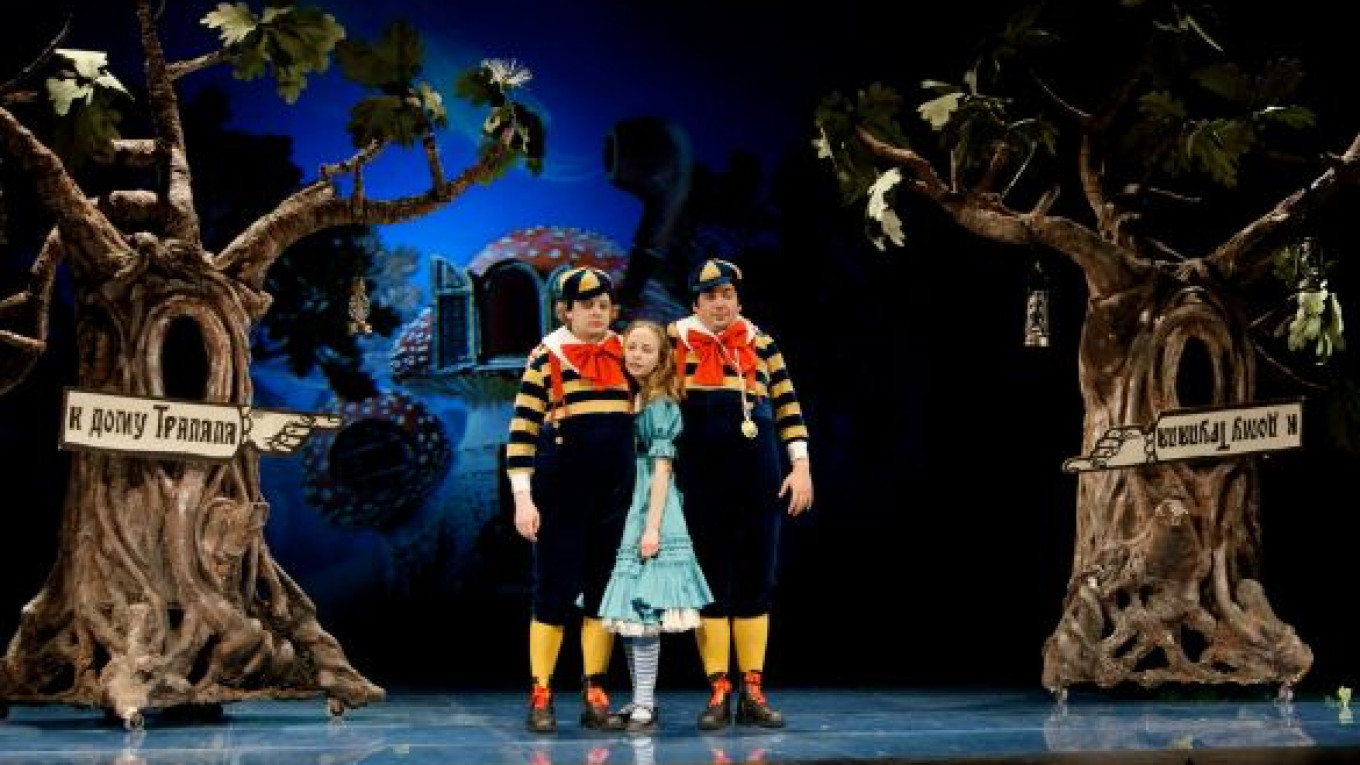One of the tasks I face annually in July would appear to be signed, sealed and delivered already. To back up my confidence in that statement I duly promise here and now, hand on heart, to eat my hat if I don’t select Ivan Popovski’s production of “Alice Through the Looking Glass” at the Fomenko Studio as this season’s most visually beautiful production.
Wow.
It isn’t the money, because money doesn’t make things beautiful. Visionary artists and talented craftspeople do. And yet Popovski surely convinced the bookkeepers at the Fomenko Studio to shell out a lot more than the usual budget for set and costumes.
Woods and castles and fanciful gardens are only the start of it. There are the animated, dreamlike scenes of village huts and angry skies that morph in and out of one another on a screen at the back of the stage. There are elaborate monsters and elegant mythical beasts. And there are laser and light effects that create a stunning moment when Alice, played with every ounce of contemporary nonchalance that Vera Strokova can muster, nearly drowns in churning, roiling waves.
“Alice Through the Looking Glass” raises the bar of Moscow theater design to a new level. I don’t recall ever seeing a show here whose visual elements were conceived and executed with such imagination and quality.
This is not, however, enough to make this show the unqualified success you might expect. Beautiful as it is, “Alice Through the Looking Glass” is almost aggravatingly long and lacking in pace and development. And the mix of folk songs and operatic-style music by Nikolai Orlovsky struck me as being more faceless than stylish.
I can imagine this show running one hour and 45 minutes as a string of enchanting pictures and scenes, and getting its message across. But at nearly three and a half hours, it plods along at the same deliberate pace as that crazy tortoise that Alice meets one day in the wood.
All of the stories from Lewis Carroll’s sequel to “Alice in Wonderland” are here, from the Jabberwocky book of backwards poetry, to Tweedledum and Tweedledee (rendered here as Trulyalya and Tralyalya and performed, respectively, by Igor Voinarovsky and Dmitry Rudkov), the Walrus and the Carpenter, and numerous knights and queens of various colors that may or may not correspond to the originals.
Some scenes, such as the encounter between Alice and the clumsy White Knight (Ivan Vakulenko), who takes it on himself to save Alice from an assailant, are so lengthy that they nearly become independent shows within the show.
Moreover, Carroll’s rich and inventive language, translated here by Nina Demurova, occasionally paralyzes the action. Alice’s meeting with Humpty Dumpty (rendered in Russian as Shaltai-Boltai and played by Vasily Firsov) seems particularly trapped.
Alice herself, whose brusque, youthful ennui makes her highly attractive, essentially does not change throughout the entire, fantastic ordeal of encountering strange figures that she is dreaming up, or that may be dreaming her. She meets each and every adventure with the same unflappable detachment.
At the beginning this is hip and humorous. By the end I could not shake the sensation that the joke was wearing thin.
Adding welcome doses of variety were the omnipresent Black Queen (Nadja Marie) and the White Queen (Monica Santoro), each of whom serves as Alice’s adversary or mentor, depending on the situation.
Popovski did much to enliven his production. Alice, particularly in the first and last scenes when she is looking for her lost kitty, spends much time wandering the hall and rummaging around beneath the feet of bemused audience members. The squeaky White Rabbit (Yelena Voronchikhina) is not the only strange creature that runs amuck among the spectators as they try to chase down Alice, one another or runaway time.
Nevertheless, “Alice Through the Looking Glass” makes it or breaks it on the basis of its considerable beauty.
And whatever complaints I may have about some aspects of this production, I was utterly slayed by its splendor.
Not surprisingly, it took an entire team of designers to work this minor miracle. The program lists the “union of designers” as consisting of Vadim Volya, Konstantin Lebedev, Vladimir Maksimov, Yulia Mikheyeva, Olga-Maria Tumakova, Ivan Popovski and the actors of the Fomenko Studio.
A special bow of reverence goes to Angelina Atlagic, who was solely responsible for the breathtaking costumes.
“Alice Through the Looking Glass” (Alisa v Zazerkalye) plays Saturday and Dec. 29 at 6 p.m., and Dec. 31 at 3 p.m. at the Fomenko Studio, located at 29 Naberezhnaya Tarasa Shevchenko. Metro Kutuzovskaya. Tel. 8 (499) 249-1921. www.fomenko.theatre.ru. Running time: 3 hours, 20 minutes.


